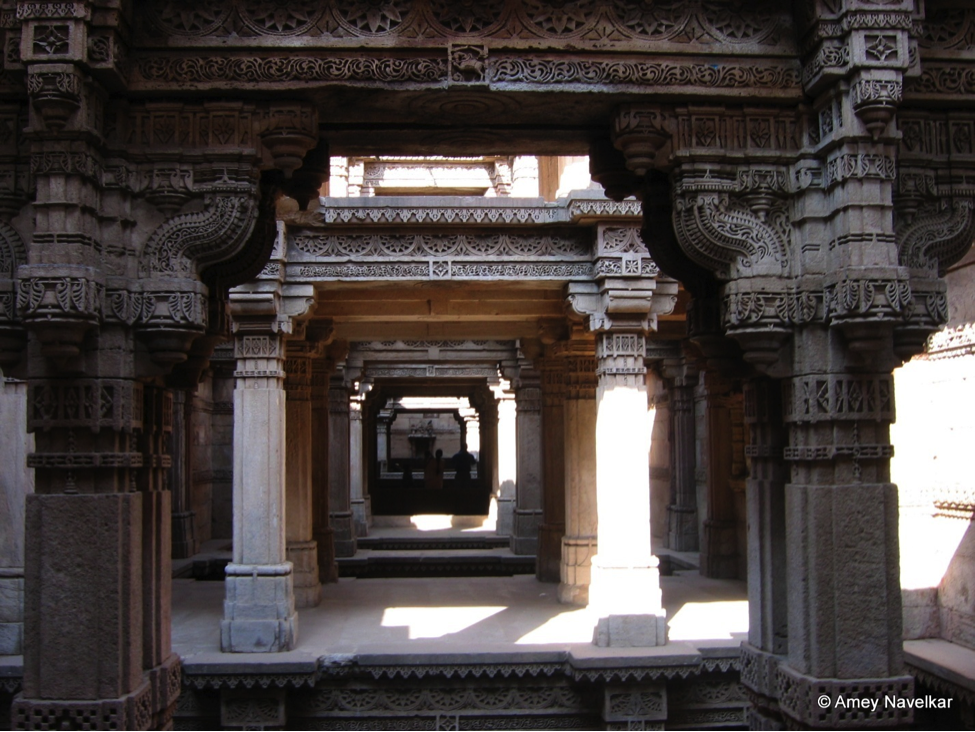If you have had a chance to visit the state of Gujarat in Western India, you have almost certainly seen atleast one of the famed step-wells in the region. Known locally as “baori” or “vav”, there are hundreds of these architectural masterpieces dotting the state. The most famous ones are the Rani ki Vav (queen’s step-well) in the town of Patan and the Adalaj Vav (pictured below) at Adalaj, about 30 kms from Ahmedabad. The former makes it to the list of UNESCO World Heritage Sites and both see thousands of visitors and tourists every year.
Major parts of Gujarat have been dry and arid for centuries, with the Thar Desert and the Rann of Kutch having a strong influence on the climatic conditions. The southern parts of the state border the saline Arabian Sea. Water, as a result, has traditionally been a precious and scarce resource. The step-wells evolved between the 6th and 11th century AD to meet the water requirements of the communities that made Gujarat their home. Today they stand testimony to the vision and empathy of the local chieftains and kings who patronized and funded their construction as a public good. They also offer some excellent lessons in product aesthetics and community development, which can be useful even in the unrelated field of software development.

User Experience: Blending Functionality with Aesthetics
The primary function of a step-well was to be a year-round source of water for the community. The deep, multistoried step-wells made the underground water table easily accessible even during the harsh summer months. It would have been economical to simply construct step-wells as a purely functional engineering structure, without the elaborate carvings, sculptures and rich ornamental decorations that we find adorning them. Aesthetics and engineering however went hand-in-hand in traditional Indian architecture, leading to a wonderful user experience. Art-forms and beauty were given equal importance along with scientific principles and construction. Software product designers and architects need to play a similar role for complex software products – features and functionality must be designed with a view of the user experience and aesthetics in mind. Users may start using your product for its features and functionality, but they will become strong champions and power-users of your product if it’s also aesthetically appealing and elegant to use.
Community Development
The step-wells served not just as a stable water source in an arid land, but also a meeting place for the community. The elaborate structures served as a place for the locals to mingle, interact and probably even spend time trading wares and services. Constructing engaging and beautiful structures served the purpose of people spending more time at the step-wells, strengthening the bonds in a migratory, nomadic and dispersed community. Software products can take a leaf out of this book to engage with their users and promote community development. Recent trends in digital transformation have shown that a strong emphasis on leveraging your user community can pay rich dividends for your products and services. Apart from functional aspects of product design and development, having features that enable users to interact with each other and a community support ecosystem that fosters such interactions is critical to product success, user adoption and longevity.
Legacy and Purpose
In the age of multi-billion dollar valuations for seemingly ephemeral apps, it’s easy to get carried away and look for short-cuts to success. As we all know however, these valuations are more black swans than de-rigueur. The patron financiers, architects and sculptors of the step-wells emphasized building something that would not only serve the people of their generation, but would have a lasting impact on the generations to come and leave a legacy. The sense of purpose was a central theme in the construction and perhaps it should be so for the software products we design as well. It may seem naïve to have this point of view given how “exit route” is one of the central discussions for any funding that is sought. But perhaps a shift in focus to the product vision and what it accomplishes for the users and society at large will help us build more enduring and endearing products.
Are there other interesting inspirations you can draw from these wonderful engineering marvels? Which is your favorite step-well and why? I’d love to hear from you!

